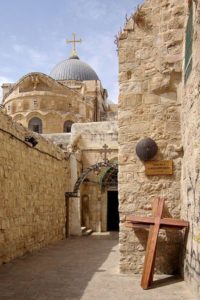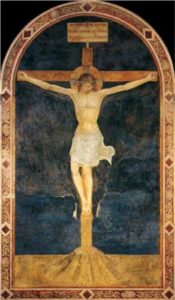
The ninth station of the cross, Via Dolorosa, Jerusalem. In the background you can see the dome of the Church of the Holy Sepulchre, the traditional site of Jesus’ crucifixion.
“Pilate also had an inscription written and put on the cross. It read, Jesus the Nazarene, the King of the Jews. Many of the Jews read this inscription, because the place where Jesus was crucified was near the city; and it was written in Hebrew, in Latin, and in Greek.” (John 19:19-20)
An intriguing passage in the Gospel of John, describing the crucifixion in great detail, including the sign written by Pilate himself and affixed to the cross. The official charge against Jesus seems to have been his challenging the authority of the Romans in Judaea by proclaiming himself, or being proclaimed, “King of the Jews”. It is quite plausible that there was such a sign, proclaiming the crime of the man being punished, as we know of this practice from other Latin historical sources of the period in which criminals are described as wearing signs around their neck, or above their bodies, describing their crime and punishment.
In fact, all four of the Evangelists mention the sign on the cross, but only in John is the sign, called the titulus in Latin, reported as being in three languages. While the discussion rages about what language Jesus himself spoke (maybe more than one?), this verse makes clear the tri-lingual nature of his Palestinian environment. The fresco below, by the Italian Renaissance painter, Fra Angelico, from a Dominican Monastery in Fiesole (1434), illustrates the languages of the inscription itself on the crossbar of the cross. This careful depiction reflects the new interest in ancient languges during the Renaissance. The Latin version mentioned in John, IESUS NAZARENUS REX IOUDAEORM, gives us the acronym INRI, an abbreviation which is found over the cross in so many images. The Greek, Ἰησοῦς ὁ Ναζωραῖος ὁ Βασιλεὺς τῶν Ἰουδαίων = Jesus the Nazaraean, the King of the Jews, gives rise to an argument between the Jews and Pilate in the following verses in John:

Fra Angelico, from a Dominican Monastery in Fiesole (1434)
“So the High Priests of the Jews kept saying to Pilate, ‘Do not write The King of the Jews, but He said I am King of the Jews.’ But Pilate answered, “What I have written, I have written.” (John 19:21-22)
What upsets the High Priests? Here is a point of Greek grammar! In English, there is a difference between saying “the book” and “a book”. “The” is called the “definite article”, and it indicates one particular, definite, book. Whereas “a” is the “indefinite article”, and it indicates any book, not yet specified. In Greek, there is also a definite article and it is used in Pilate’s inscription, referring to The King of the Jews, an absolute title. Of course, the High Priests don’t accept this title for Jesus; they are only willing to accept the fact that he could have called himself A King of the Jews, perhaps one of many people taking this title upon themselves. It is very insightful of John, both in terms of Jewish psychology, the Palestinian linguistic environment, and in his understanding of Greek grammar! Again, he is set apart from the synoptic gospels in this description of the cross. The Hebrew version given by Fra Angelico is also quite correct: ישוע הנצרי ומלך היהודים = Jesus the Nazarite and the King of the Jews. (hard to see these on the reproduction, but believe me!).
The final illustration is a unique Latin inscription. It is called the Pilate Stone and it is a block of limestone with a carved inscription attributed to Pontius Pilate, prefect of the Roman-controlled province of Judaea during the life of Jesus. The stone was found in 1961 by a team of Italian archeologists and is unique because it is the only universally accepted archaeological find with an inscription mentioning the name “Pontius Pilatus” to date – look at the end of the second line. It was found in the ancient theater built by Herod the Great, in the present-day city of Caesarea, which was the capital of the Province of Judaea at the time that Pontius Pilate was the Roman governor.









Normal:
No matter if later writers says “staurus”, “pole” or some like that; which really does matter, is the said by Jesus ” take each one his cross each day, and you, come and follow me”;
I think this way, and besides, romans were really experts in crucifying people, with preference on jews or israelians, if you like as better word. Best for you.
I would like to say that my understanding of what the Savior was killed on, according to Greek was a Stauros, an upright pale or stake, rather than the cross “crux”from the Latin, which was pieces placed at right angles. Acts 5:30; 10:39; Galatians 3:13; 1 Peter 2:24 these using “tree”. Thank you.
I recently returned from a trip to Vatican City and Rome, Italy. At my request, my daughter took a picture of a sign with pictures at the Roman Coliseum. In one of the pictures of the engravings, the crucifixion is depicted. The traditional cross is shown. There is a verse that says Yehoshua endured the shame of the cross for the joy set before him. I’m familiar with and I’ve searched out the “stauros” claim myself. Do you remember the eclipse that was seen across the United States on 21 AUG 2017? Its longest totality was no more than two minutes and forty seconds. Moreover, “The event’s shadow began to cover land on the Oregon coast as a partial eclipse at 4:05 PM UTC… [and] ended along the South Carolina coast at about 6:44 PM UTC,” (wikipedia.org/wiki/Solar_eclipse_of_August_21,_2017; accessed 19 MAR 2018). That’s less than three hours from the west coast of the US to the east coast of the US! In the New Testament, however, we are given an account of darkness over the entire land for three hours! Even if you imagine that as varying degrees of darkness, there was no doubt to those standing around that something unusual had taken place. We don’t know how much land the “whole land” included, but I cannot imagine its land area being greater than the solar eclipse that was seen across the US on 21 AUG 2017. I think the “shame” of the cross (Hebrews 12:2) was Messiah being sacrificed to the pagan sun “god,” but YHVH intervened with a supernatural eclipse followed by an earthquake that rent the curtain to the Holy of Holies in two. When I think about the verses that tell us to deny ourselves and take up our cross and follow Yehoshua, I think in terms of both sacrifice and authority- or the sphere of influence that each of us occupies. Shalom!
Shalom indeed! Thank you for pointing out this perspective, I had not made the connection with the eclipse. That is a subtlety that would only come from knowing the era well enough to see it from the eyes of the Second Temple Jew.
Shalom Eric de Jesús Mendoza !
Tu és uma benção, você fala português, Jesus falou para multidões ,mas parou para falar com Nicodemos ,sendo assim,fico feliz por você .
O REI está voltando, ele cumprirá as promessas feitas a ti.
Que o ETERNO continue a te abençoar em nome de JESUS.
BS”D
Shalom José Hélder!
Sim, pela gracia de Deus podo lêr escriver e comprender a língua portuguesa 🙂
Agora entendí melhor tuas palavras 🙂
Obrigado pela tua bençao.
Que o Senhor Yehoshua’ fique já de volta!
William – I’m sorry you were disappointed! The original stone, discovered as a re-used block in the theater, is now in the Israel Museum, Jerusalem. The one you saw was a replica…
When I visited Caesarea this past August, I looked a long time for the Pilate inscription. I finally found it in a very obscure place near the gift shop. I wonder why this important inscription has been nearly hidden.
Shabbat shalom!
Toda! Broker Tov,
I absolutely love the Jewish people you are brilliant. Thank you for the study. I was raised Catholic but the pieces didn’t fit, as I studied and prayed I started to move over more towards Judiasm. When I went to Israel my life changed, then I studied Hebrew, it more substantiated of the Truth of Adonai’s Word and beautiful plan for Israel. Everyone has a right to believe what they want as the way they are raised their culture, etc. as long as They dont harm or oppress others.
I just went back to Israel after 14 years to celebrate the holydays, what a tremendous blessing. I love your country, people and president and to learn of this fascinating nation.
” I love your country, people and president and to learn of this fascinating nation.” The Good News of the Kingdom of God, sends a personal invitation to You, Katy. It can be Your Country and You can be “Those” People. The Sons and Daughters of God, the People of my Father.
I have tracked down a source for the idea that the titulus reading in Hebrew included the sacred name.
In the book ‘The Quest for the True Cross’ by Carsten Peter Thiede and Matthew D’Ancona (Orion Books, 2000), it is stated: ‘Shalom Ben Chorin surmised that the following was the Hebrew line …Yeshu HaNozri V’Melek HaYehudim’ quoted from Ben Chorim ‘Bruder Jesus. Der Nazarener in judischer Sicht, Munich 1977.
Why does Ben Chorim think this was the Hebrew text? There is not much of the Hebrew text to be seen now on the supposed titulus preserved in the church of Santa Croce in Gerusalemme, Rome.
Consciously or not, he argues the scribe was working in the four sacred letters into the charge
interesting. thank you, Kingsley!
Shalom Eric de jesus !
Meu amado não é o conhecimento que vai atrair os judeus ao evangelho,mas o amor,é possível se conhecer as línguas dos homens,ou até mesmo a dos anjos, e ainda assim ser como o metal frio de um sino, JESUS nosso mestre alcançou multidões não com a sua oratória sofisticada,mas porquê mostrou compaixão aos excluídos.O nosso desafio é imita-lo ,só que misericórdia não se aprende com a mente ,mas com o coração,não é em faculdades,mas aos pés de Y´HOSHUA.
Um abraço Eric que D-US continue a te abençoar em nome de JESUS!
BS”D
‘Amen irmâo. Obrigado.
Eu quero te recomendar escriver no bloge em Português, pra que tudos podam te-entender.
A morte de nosso SENHOR JESUS CRISTO na cruz é o maior mistério das Escrituras sagradas, é o mistério da piedade ,a maior Tsedaká realizada pelo próprio ETERNO.
Shalom ISRAEL!
BS”D
Shalom José!
quero que os seus comentàrios sejam bem valorados, por isso, te pido escriver no blog em português! 😀 cá casi ninguem fala português só Inglês… obrigado!
A justiça e paz se encontraram, a graça e verdade se beijaram,onde?em quem?
No monte gólgota,na cruz,em JESUS CRISTO!
Que o ETERNO continue vos abençoando.